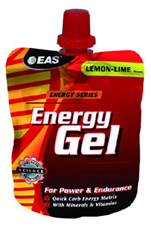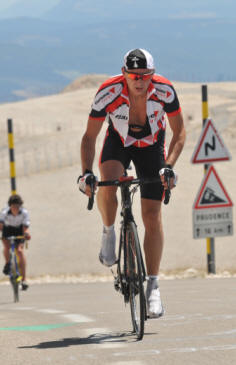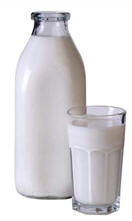Sports Nutrition

To help better understand this factsheet, it might help if you knew how your body processes the food you eat and over what timescales things happen. Here's a quick review of the Digestive Process.
Food Energy Make Up
All foods are made up of the nutritional building blocks of
carbohydrates, fats, and protein plus a certain amount of water and
fibre (indigestible and without any food value).
Carbohydrates contain 4.1 Calories per gram and are the primary source of energy for most cyclists and endurance athletes. Fats are more important for slower endurance events and contain 9 Calories per gram.
Protein's main use (again 4 Calories per gram), is to maintain and repair the body's cells. Protein is rarely available as a source of energy to an athlete, if you're using protein as fuel you're in big trouble! But that doesn't mean it should be ignored.
The chart at the top of the page is the replacement for the now outdated food pyramid. It shows the correct ratio of what should be eaten to maintain a balanced diet. When training, these ratios may need to be "tweaked" and to do that you need the advice of a qualified sports nutritionist.
Muscle Energy Supply
Although
carbohydrates supply the majority of the energy for muscles during
vigorous activity, fats, if you use the correct training methods, can be a major
fuelling contributor for less strenuous efforts.
Carbohydrate is stored as glycogen in muscle and liver cells. In a balanced sports diet there should be enough glycogen to support around 90 minutes of sustained exercise before depletion occurs. Or, to put it another way, the fuel tanks run dry.
 Obviously, these
internal stores can be replenished "as you go" through eating
the right amount and type of carbohydrates, at the right time.
Obviously, these
internal stores can be replenished "as you go" through eating
the right amount and type of carbohydrates, at the right time.
You need to begin eating almost as soon as the event is under way, as eating after the bonk has occurred is infinitely less effective and desirable from a performance view-point.
A shift toward fat metabolism may be the physiological explanation for the "second wind" that occurs during long exercise sessions or races.
It's thought that once internal carbohydrate stores have been depleted and fatigue sets in, the body's survival mechanism awakens and shifts the emphasis to fat metabolism.
This feeling of a renewed energy source being ignited, becomes apparent and exercise, although at a somewhat reduced intensity, can be resumed.
The trade off is the inability to maintain performance at previous percentage levels of VO2max that were possible with a carbohydrate supported energy production.
In other words, you can carry on, but not at the rate you maintained when you had carbohydrates as your fuel source.
 Factors Effecting Digestion & Absorption
Factors Effecting Digestion & Absorption Planning a nutritional strategy to supplement the body's energy stores for a big event, requires careful planning. The rate of digestion and absorption of foods must be taken into account to ensure a constant, uninterrupted and steady release of energy.
The time needed for the stomach to start the digestive process, empty its contents into the small intestine, and have the food components absorbed into the bloodstream will directly affect how quickly any food will be available to the muscles to provide energy for the ride.
As an athlete
you have control over four major factors that influence the digestive
process.
▼ Solid v liquid ~ liquids are
metabolized quicker than solids
▼
Fat content of the food ~ fat slows the
digestive process
▼
Sugar concentration ~ more than 10% slows
stomach emptying
▼
Physical activity level ~ digestion is
slowed when over 70% VO2max
From the above four points, it is easy to see that the optimal food for a rapid, high energy boost during a ride would be a semi-liquid (gels) or liquid carbohydrates with minimal, if any, fat content.
On the other hand, for endurance events competed at a lower VO2max (Cyclosportives, Iron Man Triathlons, End-to-End attempts), a complex, solid form of carbohydrate (energy bar), with some fat added to improve taste will slow emptying from the stomach and even out absorption over a longer period of time.
Exercise Effects On Digestion
 Studies have
consistently demonstrated a reduced blood flow to the digestive
system during vigorous exercise.
Studies have
consistently demonstrated a reduced blood flow to the digestive
system during vigorous exercise.
After one hour of cycling, at 70% of your VO2max, there is an 80% reduction of blood available for food digestion than there is at rest. Blood goes primarily to your muscles and it can't (figuratively speaking) be working in two places at once.
Exercise delays stomach emptying, and the more vigorous the exercise, the greater the delay. Just when you need it the most, it's not available!
Training Nutrition
It is suspected that one component of overtraining
may be a
failure to adequately replace the muscle glycogen depleted as a result
of intense, consecutive training sessions.
To minimize the risk of the short-term bonk, and potential long-term overtraining issues, it is important to maximize your body's glycogen stores through ensuring a:
▼ high carbohydrate diet in the
days and hours before your ride
▼ steady consumption of carb
gels, bars & drinks, while competing
▼ full and immediate use of
the post ride recovery window
Pre-Event Nutrition?
The good old days? As far as
the pre-race period is concerned, dismiss from your mind everything
you've heard about traditional carbo-loading.
All the rage when I started racing in the 80's, which is where it should remain. It involved avoiding all carbohydrates for several days in the week prior to the event, while still training hard, to ensure complete and absolute muscle glycogen depletion. Once that point had been reached you'd eat nothing but carbohydrates for the 3 days immediately prior to the key event.
Although this regimen does maximise muscle glycogen stores, the price to be paid has significant physical, mental, physiological and digestive drawbacks. It was effective, but very crude.
Thankfully, nutritional science has advanced greatly since that program was devised. Remember, in those days we were led to believe steak (the rarer the better) was optimal race fuel!
So, to clarify; sticking to a normal, athletes, high carbohydrate diet, without a depletion phase, will provide over 90% of the benefits of the loading program above, while avoiding 100% of the digestive and physiological turmoil that accompanies it.

Event Nutrition
Maximizing your carbohydrate replacement during competition is vitally important for
events of more than two hours.
Your body can only process around two grams of carbohydrate per minute. This is all that can be absorbed and utilized to supplement previously digested pre-ride glycogen stores to help sustain prolonged intense exercise.
As a rule of thumb, the higher the intensity of the competition (closer to your VO2max), the simpler the carbohydrate replenishments (energy drinks, gels, and fruits) should be.
On longer rides and at lower heart rates, more complex carbohydrates and a higher fat content offer more viable alternatives.
A reasonable goal during high intensity rides is to consume around 200 to 300 Calories (60 grams of carbohydrate) per hour.
Commercial power bars and sports drinks are often advertised as providing a particularly potent combination of ingredients and secret "supplements".
However, they are no more effective on a gram for gram basis, as an energy booster, than any other carbohydrate source. One big advantage is that they are pre-packed, readily available and do offer a potentially better taste and texture option for a mid-competition snack.
What you are buying is convenience and accurately measured portion control of simple sugars. With a few added vitamins and minerals.
Recovery Nutrition
We'll cover this in
more depth in a separate dedicated factsheet; but for now you need to be aware
of the twenty minute "recovery glycogen window" that is open immediately
following vigorous exercise and starts to close as soon as you back off.
During this "window", ingested carbohydrate will be converted into muscle glycogen at about three times the normal rate. The earlier your recovery starts, the more complete, thorough and beneficial it will be.
Food taken during the first twenty minutes of finishing exercise gets on the glycogen autobahn and screams into the muscles and liver at a phenomenal rate.
During this time, your body acts like a human sponge sucking up all the nutrients it can, in a mad panic before the "twenty-minute window" begins to close. After four hours it's shut off altogether and nutrient absorption returns to it's country lane way off life.
But you need to be careful what you eat.
Many simple carbohydrate snacks such as biscuits are more than 30% fat and if eaten in large quantities to boost recovery (which they wont), you might exceed your planned daily fat intake.

In contrast, complex carbohydrate foods such as pasta, bread, and rice offer significantly more carbohydrate per gram.
There are even special "recovery drinks" available to give you what you need when you need it. And protein should not be overlooked as a vital factor in muscle repair.
There is also suggestive evidence that the muscle stiffness occurring after vigorous exercise (DOMS) may be related to muscle glycogen depletion.
So, rapid
repletion may have the added benefit of minimizing this day after effect
as well. Lots of "mays" there but it may work for you, so why
not try
it for yourself before you discount it?
Hydration
Water
does not provide any calorific value whatsoever. However, adequate hydration is
as important to performance as the food you eat.
One of the biggest mistakes made by new, and many experienced, cyclists is their failing to replace fluid losses associated with exercise.

Cycling, and moving through the air at a speed proportional to our effort, causes rapid skin evaporation, thus decreasing the sense of fluids lost through perspiration.
Sweat production and fluid loss through the lungs can easily exceed a pint per hour. When standing in the cold waiting for your club run to start, look at the steam coming from your breath. That's water that is. It still happens on a warm day, you just don't get to see it!
Fluid losses during exercise result not only in decreased plasma volumes, but also in muscle water content depletion.
Dehydration of as little as 2% fluid loss, begins to impact heat regulation. At 3% there is a measurable effect on muscle fibre contraction and when dehydration reaches 4% there is up to a 10% drop in previous, fully hydrated, performance levels.
You may think a 4% drop is a lot and you'll never get near that in a ride. But what happens if you already come to the start line 2% dehydrated?
If you work in an air-conditioned office, drive to your event in an air conditioned car, or spend Saturday afternoon working in the garden, it's very likely that you may not be fully hydrated when you start your event on Sunday morning. Especially if you race early morning and have spent the previous eight hours in bed since your last drink.
Hydration is an important part of your race preparation. Practice until you get it right.
The Message
Nutrition and hydration strategies are as important a part of
your competition as the training you undertake, the equipment you buy,
and the mental preparation you invest.
You can do as much of the above as you like but if your nutrition strategy is wrong, it will be reflected in your results.
Would you feed a Grand National prospect the same food you'd give a beach-ride donkey? Absolutely not! As athletes who train and race more days than we rest, we can't get away by eating and drinking the same as "normal" people.
Performance humans require performance nutrition. Give the food you eat the attention it deserves. As the old computer phrase goes, "rubbish in ~ rubbish out".
There are two sets of bottle cage bosses on your bike for a reason. Always put two bottles on your bike always! And when you train, always put two bottle on your bike. If you don't drink what's in the second one, at least it's helped you as a training aid.
Drink a little often, rather than gulping mouthfuls every half-hour. Keep topped up and keep your performance levels consistent. Eat before you're hungry and drink before you're thirsty. By the time you feel you need to do either, it's too late. The damage is done and may be irreparable in this ride, or the next!
Money spent on the advice of a qualified sports nutritionist may help you find that extra 1% that you need to win races or go for your personal best. For the price of a pair of tubs you can improve your results by factors greater than any pair of wheels or fancy frame could ever do.
Check-out our services page to find someone who has already helped some of our riders to improved performance.








